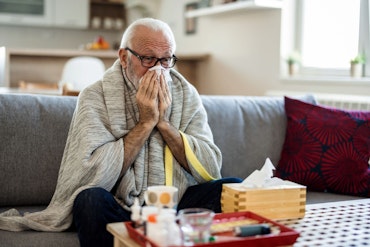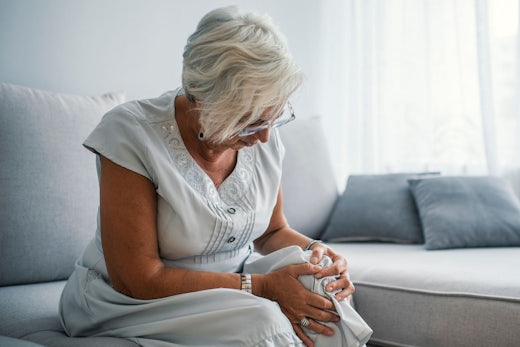How do I continue to get healthcare if I am self-isolating?
As more and more businesses close and the Government takes action to minimise the spread of the coronavirus, or COVID-19, you may be in self-isolation or worried about going to your doctor’s surgery, how are you able to access healthcare while at home?
![<p>Telehealth is the utilisation of technology, or virtual technology, to provide healthcare outside of a normal doctors clinic or hospital. [Source: Shutterstock]</p>](https://agedcareguide-assets.imgix.net/news/articles/telehealth-20_3_20.jpg?fm=pjpg&format=auto&w=550&q=65)
Telehealth is the utilisation of technology, or virtual technology, to provide healthcare outside of a normal doctors clinic or hospital. [Source: Shutterstock]
Luckily, telehealth is being pushed by the Federal Government, making healthcare more accessible and as a way to protect vulnerable Australians from the possibility of contracting the virus.
What is telehealth and why is it important?
Telehealth is the utilisation of technology, or virtual technology, to provide healthcare outside of a normal doctors clinic or hospital. This could be on your phone or on your computer/laptop with a camera or a webcam.
The innovative solution was already reaching some regional and remote areas of Australia where access to general healthcare may be limited, but is now increasingly becoming a more common option across the country for a range of health services during the coronavirus pandemic
The Australian Medical Association (AMA), says, “Under normal circumstances, it can considerably enhance access to General Practitioner (GP) services for specific patient groups including patients in aged care. It complements but does not replace face to face patient consultations.
“However, in these extreme circumstances of a pandemic, telehealth can be a particularly efficient mode of provision of care for older patients and those residing in aged care facilities. It can reduce unnecessary visits to aged care facilities by doctors or unnecessary patient transfers to hospitals and thereby reduce the possibilities for transmission.
“GPs who are already overwhelmed by providing services for patients in their clinics can provide care for their patients in aged care by telephone or video consultations, speak to the nurses working in aged care facilities and provide relevant medical advice on how to proceed with treatment of those patients.”
The good thing about telehealth is that it can transmit voice, data, images and information to a recipient rather than moving the recipient to the health professional, especially if the recipient is fragile or immunocompromised.
Telehealth can also be a solution if you’re struggling to find someone to take you to your doctor’s appointments.
The World Health Organisation (WHO) says telehealth is the most basic form of “eHealth” and is used often by people with chronic illnesses or by the elderly.
The Australian Federal Government has decided to pump extra funds into the country’s telehealth services to help contain the spread of the coronavirus by reducing human to human contact.
A part of the Government’s $2.4 billion health package, around $100 million will be going into this new Medicare service for people who are in home isolation or quarantine. They will be able to receive a health consultation via phone or video.
The Telehealth Medicare Benefits Schedule changed on 13 March to allow GPs and non-specialist medical practitioners to treat COVID-19.
However, since 30 March, telehealth services were made general in nature for health appointments, instead of just for suspected or treating COVID-19 cases.
Telehealth can be used for a majority of consultations that would usually be undertaken face to face. Although, some appointments may require physical examinations.
People eligible to use the telehealth service include people aged over 70, people with chronic diseases, Aboriginal and Torres Strait Islander people aged over 50, and people who are immunocompromised.
How does it work?
An older person would need to organise a telehealth consult by contacting their usual GP or allied health professional to make an appointment, and then indicate that they want to have their consultation via telehealth.
A GP clinic may even propose the telehealth option when booking an appointment or your doctor may suggest moving your current appointments to online.
The AMA says, “In the time of pandemic, this may be the preferred option both for the doctor and for the patient as it minimises the risk of exposure to COVID-19.
“Under the Medicare Benefits Schedule (MBS), videoconference services are the preferred approach for substituting a face-to-face consultation. When video conferencing is not available, health practitioners may also offer audio-only services via telephone.”
In the case of physiotherapy, it can mean that the client will need to demonstrate they can do an action or movement correctly on camera.
The physiotherapy team at PhysioWest in Adelaide regularly uses telehealth to support their clients.
Bec Clare, co-founder of PhysioWest in Adelaide, says, “Traditionally, physiotherapy is largely a contact industry, that is the service we provide. We provide it in clinic, we provide it in the home, we provide it on-site, and have always had some element of telehealth.
“But as people are now choosing to self-isolate or they are in a risk category, we still need to be able to reach them and still continue to provide care. Probably more than ever, we need to keep up the community’s immunity and exercise is a significant component of that.
“Not only that, when people are self-isolating [mental health] is a huge concern, we may be one of the only providers or people they have come into contact with, via telehealth, over an isolation period.”
There are a number of video calling services that can be used during a telehealth consultation.
Ms Clare says their video consultation service, Cliniko, allows them to communicate with their rural and remote clients, show instructive videos to them, chat and demonstrate stretches and movements.
How to set it up?
Make sure to ask your healthcare or allied health provider if telehealth is an option that you can explore so you don’t have to leave your home but can still get the help you require.
In the instance of PhysioWest, there is zero installation required, all the client needs is a smartphone, tablet or computer.
For other video applications, staff should be able to help their patients set up the service over the phone or could even send an installation link to their client to open, which automatically puts them into a browser on a smartphone, tablet or computer to sign up to the video format of the providers choice.
Your healthcare or allied service provider should be able help you through the setup process, whether that be by phone or email.
If you are wondering whether telehealth is an option for you, it can be a good idea to test if your computer and internet bandwidth has the capabilities to host a video link.
Ask your tech-savvy children, grandchildren or friends to help you set up for a telehealth consultation. Otherwise, your Home Care Package provider or aged care facility staff may be able to help you.
Get healthcare when you need it and keep fit during isolation
Getting healthcare during this current pandemic is vital for the health of older Australians.
The AMA says, “Apart from being their basic human right, appropriate health care will ensure older people continue to have the best possible quality of life in their place of living, be it in their homes or residential aged care.”
Older people in residential aged care are older and more frail than the general population and usually have multiple comorbidities.
AMA explains that the statistics show that around 52 percent of all aged care residents have dementia; 85 percent of people who enter aged care are 75 years and older and over 50 percent of that number are people over the age of 85.
Additionally, the average number of medications per resident in residential aged care facilities is 9.75.
The AMA says, “These numbers clearly indicate why it is imperative that older people continue receiving health care.”
Telehealth can also enhance older people’s access to GP services in a time of crisis.
PhysioWest adds that telehealth also provides an opportunity for older Australians to monitor their own health and fitness and continue to have access to support services to improve health and mobility.
Matt Nowosilskyj, clinical mentor and physiotherapist at PhysioWest, says the biggest problem for older people who are isolated at home will be their mental health and the likelihood of their physical capacity declining.
“From a physical health perspective, the cardiovascular and respiratory benefits are very well researched, the literature backs up exercise. The more frequent and persistently you are moving, the better health outcomes you will have in the long term,” says Mr Nowosilskyj.
“And from a joint perspective, which in physio we do a lot of hips, knees, shoulders and things like osteoarthritis, again, all the evidence and research is heading towards and strongly stating that keeping moving regularly is important.”
Mr Nowosilskyj explains that while it will be difficult for older people to get used to telehealth consultations, it is a great way to continue getting the support and healthcare you need.
“A common misconception or view in the community is that physio requires touch, but a lot of what we do is education and empowerment,” says Mr Nowosilskyj.
“If we can empower people in their own home to keep moving in safe ways with good techniques at prescribed levels of intensity, then it is giving them the best foundation to stay healthy.”
It is likely that health services will be delivered in the home setting via a video link for the next few months depending on how the coronavirus evolves.
Electronic medication prescriptions
Not only are doctor’s appointments going online, so are prescriptions!
The Australian Government is also pushing through electronic prescribing, or ePrescribing, for at-risk groups in the community to protect them from exposure to the coronavirus.
Your doctor will be able to prepare a prescription for medication electronically. You will receive that prescription electronically, which you can send on to a pharmacist.
From there, your pharmacist will organise your medication and have it delivered to your home.
Unless you are in quarantine, you can go outside for essential services
Healthcare and allied health services are an important part of human life and the coronavirus shouldn’t sway you from accessing these vital services.
Ms Clare from PhysioWest says that healthcare offices and clinics are the safest places to go during times like this because clinics have extra precautions in place to stop the spread of germs and viruses, however, “If a client feels they are safer in their own environment, we respect that too.”
Telehealth is a big unknown for people, especially the older generation, but telehealth technology has been around for a long time and is well designed to cater for times like this.
Ms Clare expects the healthcare industry will increasingly be making a pivot to this new technology so they can continue to care for their clients.
Do you have any questions about the coronavirus that you want answered? Tell us in the comments below.
Related content:
How to self-isolate and tips on not getting bored indoors
Government suggests further protective measures for older Australians
Coronavirus stimulus package boosts aged care











![The new Aged Care Act exposure draft is slated for release in December of 2023, but advocates hope to see it rolled out on January 1, 2024. [Source: Shutterstock]](https://agedcareguide-assets.imgix.net/news/articles/wp/agedcareact__0811.jpg?fm=pjpg&w=520&format=auto&q=65)












Comments